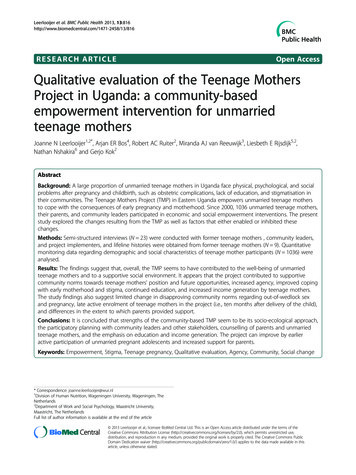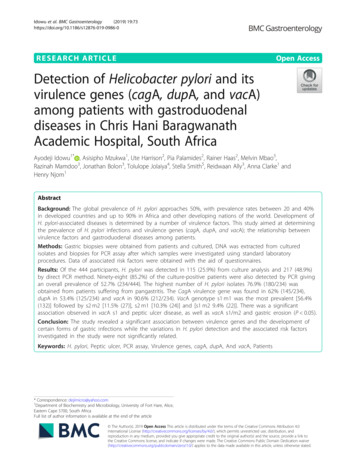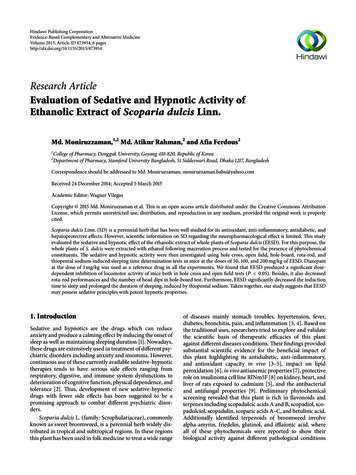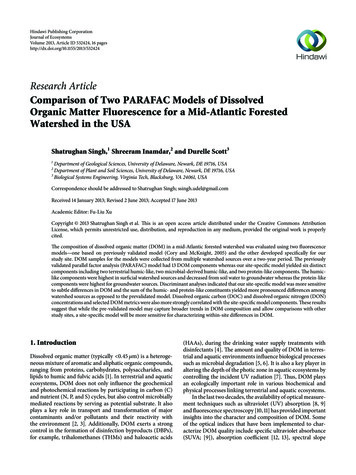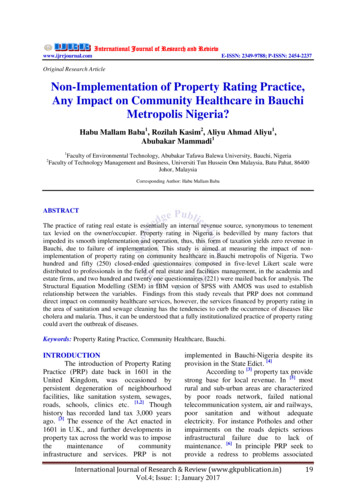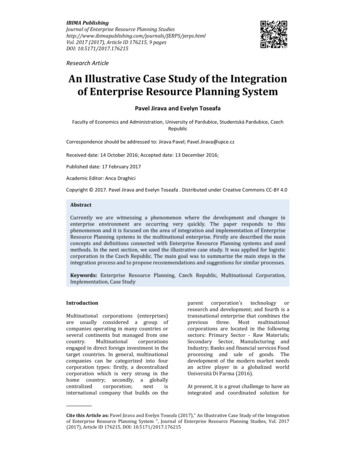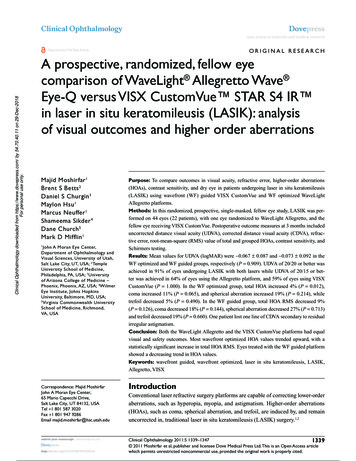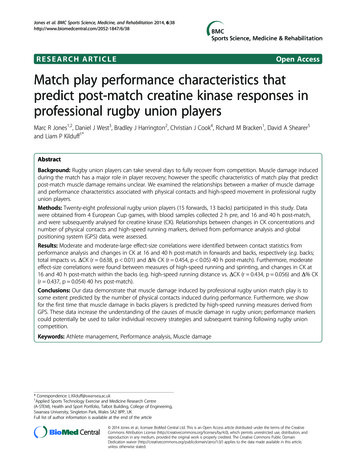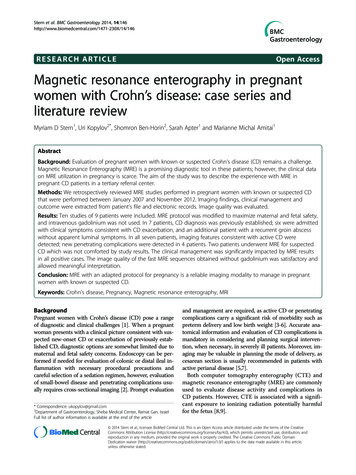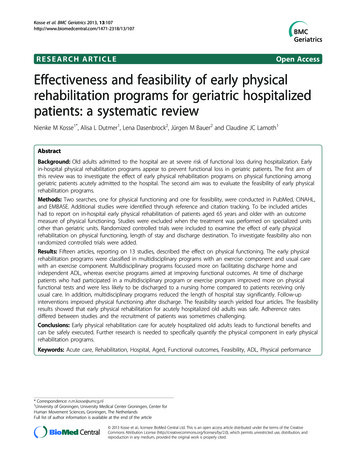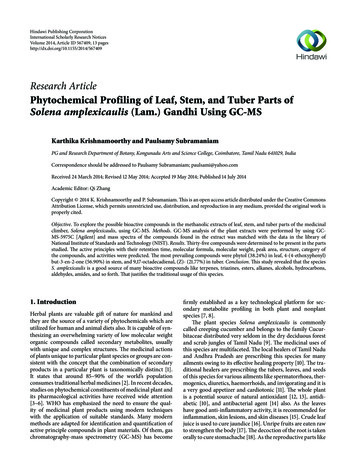
Transcription
Hindawi Publishing CorporationInternational Scholarly Research NoticesVolume 2014, Article ID 567409, 13 pageshttp://dx.doi.org/10.1155/2014/567409Research ArticlePhytochemical Profiling of Leaf, Stem, and Tuber Parts ofSolena amplexicaulis (Lam.) Gandhi Using GC-MSKarthika Krishnamoorthy and Paulsamy SubramaniamPG and Research Department of Botany, Kongunadu Arts and Science College, Coimbatore, Tamil Nadu 641029, IndiaCorrespondence should be addressed to Paulsamy Subramaniam; paulsami@yahoo.comReceived 24 March 2014; Revised 12 May 2014; Accepted 19 May 2014; Published 14 July 2014Academic Editor: Qi ZhangCopyright 2014 K. Krishnamoorthy and P. Subramaniam. This is an open access article distributed under the Creative CommonsAttribution License, which permits unrestricted use, distribution, and reproduction in any medium, provided the original work isproperly cited.Objective. To explore the possible bioactive compounds in the methanolic extracts of leaf, stem, and tuber parts of the medicinalclimber, Solena amplexicaulis, using GC-MS. Methods. GC-MS analysis of the plant extracts were performed by using GCMS-5975C [Agilent] and mass spectra of the compounds found in the extract was matched with the data in the library ofNational Institute of Standards and Technology (NIST). Results. Thirty-five compounds were determined to be present in the partsstudied. The active principles with their retention time, molecular formula, molecular weight, peak area, structure, category ofthe compounds, and activities were predicted. The most prevailing compounds were phytol (38.24%) in leaf, 4-(4-ethoxyphenyl)but-3-en-2-one (56.90%) in stem, and 9,17-octadecadienal, (Z)- (21.77%) in tuber. Conclusion. This study revealed that the speciesS. amplexicaulis is a good source of many bioactive compounds like terpenes, triazines, esters, alkanes, alcohols, hydrocarbons,aldehydes, amides, and so forth. That justifies the traditional usage of this species.1. IntroductionHerbal plants are valuable gift of nature for mankind andthey are the source of a variety of phytochemicals which areutilized for human and animal diets also. It is capable of synthesizing an overwhelming variety of low molecular weightorganic compounds called secondary metabolites, usuallywith unique and complex structures. The medicinal actionsof plants unique to particular plant species or groups are consistent with the concept that the combination of secondaryproducts in a particular plant is taxonomically distinct [1].It states that around 85–90% of the world’s populationconsumes traditional herbal medicines [2]. In recent decades,studies on phytochemical constituents of medicinal plant andits pharmacological activities have received wide attention[3–6]. WHO has emphasized the need to ensure the quality of medicinal plant products using modern techniqueswith the application of suitable standards. Many modernmethods are adapted for identification and quantification ofactive principle compounds in plant materials. Of them, gaschromatography-mass spectrometry (GC-MS) has becomefirmly established as a key technological platform for secondary metabolite profiling in both plant and nonplantspecies [7, 8].The plant species Solena amplexicaulis is commonlycalled creeping cucumber and belongs to the family Cucurbitaceae distributed very seldom in the dry deciduous forestand scrub jungles of Tamil Nadu [9]. The medicinal uses ofthis species are multifaceted. The local healers of Tamil Naduand Andhra Pradesh are prescribing this species for manyailments owing to its effective healing property [10]. The traditional healers are prescribing the tubers, leaves, and seedsof this species for various ailments like spermatorrhoea, thermogenics, diuretics, haemorrhoids, and invigorating and it isa very good appetizer and cardiotonic [11]. The whole plantis a potential source of natural antioxidant [12, 13], antidiabetic [10], and antibacterial agent [14] also. As the leaveshave good anti-inflammatory activity, it is recommended forinflammation, skin lesions, and skin diseases [15]. Crude leafjuice is used to cure jaundice [16]. Unripe fruits are eaten rawto strengthen the body [17]. The decoction of the root is takenorally to cure stomachache [18]. As the reproductive parts like
2 10516.31218.0016.0017.0015.0014.0012.00Time2. Materials and MethodsFigure 1: GC-MS chromatogram of methanolic leaf extract ofSolena amplexicaulis. 16.0018.84419.07716.306 .00Abundance2.1. Collection, Identification and Preparation of Plant Materials. The leaf, stem, and tuber parts of S. amplexicauliswere collected separately from the thorny scrub jungles ofMadukkarai, Coimbatore District, Tamil Nadu, India. Theauthenticity of the plant was confirmed in Botanical Surveyof India, Southern Regional Centre, Coimbatore, by referringto the deposited specimen (Voucher specimen number: CPS313). They were washed thoroughly in tap water, shade-dried,and then homogenized to fine powder and stored in air ds and tubers are exploited severely for medicinal uses, thisspecies becomes rare sighted in its habitats of Tamil Nadu.Despite these wide medicinal uses, no information onqualitative account of phytochemicals is available for thisspecies. To address this lacuna, GC-MS studies were undertaken to explore the phytochemical constituents present inthe leaf, stem, and tuber parts of S. amplexicaulis.International Scholarly Research NoticesTime2.4. Identification of the Compounds. To identify the compounds, the extract was assigned for comparison of theirretention indices and mass spectra fragmentation patternswith those stored on the computer library and also withthe published literature. National Institute of Standards and 07318.51020.13318.58332.14217.83713.77816.064 0032.002.3. GC-MS Analysis. GC-MS analysis was carried out ona 5975C Agilent equipped with a DB-5ms Agilent fusedsilica capillary column (30 0.25 mm ID; film thickness:0.25 𝜇m), operating in electron impact mode at 70 eV. Purehelium (99.999%) was used as carrier gas at a constant flow of1 mL/min and an injection volume of 1 𝜇L was employed (splitratio is 10 : 1). Mass transfer line and injector temperaturewere set at 230 and 250 C, respectively. The oven temperaturewas programmed from 70 (isothermal for 3 min) to 300 C(isothermal for 9 min) at the rate of 10 C/min. Total GCrunning time was 34 min and the MS detection was completed within 35 min.By GC-MS, the compounds were separated and then theywere eluted from the column and made enter into the detectorwhich was capable of creating an electronic signal. Thenthey were processed by the computer for generating chromatogram. Then the compound entered into the electron ionization (mass spectroscopy) detector, where they were bombarded with a stream of electrons causing them to break apartinto fragments. These fragments were actually charged ionswith certain mass. The m/z (mass/charge) ratio obtained wascalibrated from the graph, called the mass spectrum, and isthe fingerprint of the molecule.Figure 2: GC-MS chromatogram of methanolic stem extract ofSolena amplexicaulis.Abundance2.2. Preparation of Extract. 50 g of powdered leaf, stem, andtuber parts of S. amplexicaulis was separately extracted with250 mL methanol at the temperature between 60 and 65 C for24 h by using soxhlet extractor. The solvent was evaporatedby rotary vacuum evaporator to obtain viscous semisolidmasses. This semidry methanolic crude extract was subjectedto GC-MS analysis.TimeFigure 3: GC-MS chromatogram of methanolic tuber extract ofSolena amplexicaulis.Technology library sources were also used for matching theidentified compounds from the plant materials [19, 20].3. ResultsThe gas chromatograms of leaf, stem, and tuber parts ofS. amplexicaulis confirmed the presence of various interesting compounds with different retention times as illustratedin Figures 1, 2, and 3. These compounds were identifiedthrough mass spectrometry attached with GC. The identifiedcompounds and their retention time, molecular formula,molecular weight, peak area (%), structure, category ofthe compound, and activities related with medicinal usesare given in Tables 1, 2, and 3 for leaf, stem, and tuber,respectively. The compound prediction is based on Dr.Duke’s Phytochemical and Ethnobotanical Databases. Sixcompounds were detected in the methanolic leaf extractof S. amplexicaulis. Among them, the most prevailingmajor compounds were phytol, a diterpene (peak area:38.24%) (Figure 4(a)), carane, a terpene (peak area: 18.76%)
)16.317C20 H40 OC15 H22 O2C10 H18C14 H31 N1-Tetradecanamine 12.091CaraneC8 H19 N11.990C12 H17 phenyl]-1-OctanamineMolecularformulaRTName of ecularweight38.245.8518.7610.2416.1610.75Peak area %Source: Dr. Duke’s Phytochemical and Ethnobotanical Databases (online database).654321S. numberH3 CCH3H3 CH3 CH3 rpeneAliphaticdiketoneTerpeneAliphatic amineAliphatic amineAromaticpiperidineCategory of thecompoundTable 1: Compounds identified in the methanolic leaf extract of Solena amplexicaulis by GC-MS.Anticancer, antioxidant,anti-inflammatory, diuretic,antitumor, chemopreventive,antimicrobial, use in vaccineformulationsNo activity reportedAntifeedant, antioxidantNo activity reportedNo activity reportedNo activity reportedActivity International Scholarly Research Notices3
idine45C13 H9 NO5C4 H8 N6 O2C11 H24C5 H6 O2Molecularformula10.261 C7 H16 N4 O4 S210.2181,2,4-Triazino [5,6-E][1,2,4]-triazine-3,6-dione, 7.633hexahydro-3.9291,3-Cyclopentanedione13RTS. number Name of the ht0.170.520.363.924.47Peak area%OO SONHOHNH3 CNO N NHHNOOONONHCH3S OOONHOHNHHNStructureTaurine aminoacid derivativeAromatic nitrocompoundTriazineAlkaneCyclic diketoneCategory of thecompoundTable 2: Compounds identified in the methanolic stem extract of Solena amplexicaulis by umor properties,anti-infective agents,antineoplastic agentsNo activity reportedNo activity reportedAntimicrobial agents, transducerfor immunosensor and itsmethod of production.carcinogens, enzyme inhibitors,solventsNo activity reportedActivity 4International Scholarly Research Notices
C12 H22 O11C7 H14 O7C10 H12 O3C16 H30 O212.469Trehalosed-Glycero-d-tallo-heptose 12.701Benzaldehyde, -1-ol, acetate,16.303(Z)-78910C12 H14 -2-oneRT6S. number Name of the ght1.401.711.6811.4956.90Peak area%H3 CHOOHH3 COOCH3OHOHOOOHOCH3CH2 OHOHHOOOHOHOOCH2 OHH3 COCH3StructureOHOHH3 COHOCH2 OHTable 2: Continued.Aliphatic esterAromaticbenzaldehydeAldo heptoseSucroseAliphatic acidCategory of thecompoundNo activity reportedNo activity reportedNo activity reportedTreat amyloidosis (prevent thedeposition of amyloid protein inthe body)No activity reportedActivity International Scholarly Research Notices5
19.077Heptadecanoic acid,10-methyl-, methyl ester1415 C8 H9 N5 O218.975Benzaldehyde, .48178.31270.45MolecularweightSource: Dr. Duke’s Phytochemical and Ethnobotanical Databases (online database).C19 H38 O2C19 H36 O2C13 H229-Octadecenoic acid (Z)-,18.844methyl ester17.5811-Methyl-3ethyladamantane12C17 H34 O2Molecularformula1317.174Hexadecanoic acid,methyl esterRT11S. number Name of the compound1.291.426.761.376.52Peak area%OH3 CH3 CH3 CO OOOCH3N NO H NHNStructureCH3Table 2: Continued.N HHHCH3OOCH3CH3CH3Fatty esterNitrogencompoundLinoleic acidesterBicyclic alkaneLinoleic acidesterCategory of thecompoundNo activity nic cancerpreventive, dermatitigenichypocholesterolemic,5-alpha reductase inhibitor,anemiagenic, insectifugeNo activity reportedAnti-inflammatory,hypocholesterolemic, cancerpreventive, hepatoprotective,nematicide, insectifuge,antihistaminic, antieczemic,antiacne, alpha reductaseinhibitor, antiandrogenic,antiarthritic, anticoronaryActivity 6International Scholarly Research Notices
13.77616.07117.18917.84218.176Dodecanoic acidTetradecanoic acid1,2-Benzenedicarboxylicacid, bis(2-methylpropyl)esterPentadecanoic acid,14-methyl-, methyl estern-Hexadecanoic acidCystodytin1-Decanol, 2-hexyl-12345678C16 H32 O2C17 H34 O2C16 H22 O4C14 H28 O2C12 H24 O2MolecularformulaC16 H34 OC19 H34 O218.58310,13-Octadecadienoic acid,19.469methyl ester18.510 C22 H19 O3 N3RTS. numberName of the 2.40Peakarea %OH3 CCH3H3 CH3 COCH3H3 CH3 CH3 3CH3CH3Linoleic c acidFatty esterPhthalic esterMyristic acidFatty acidsCategory ofthe compoundTable 3: Compounds identified in the methanolic tuber extract of Solena amplexicaulis by GC-MS.Anti-inflammatory,hypocholesterolemic, cancerpreventive, hepatoprotective,nematicide, insectifuge,antieczemic, anticancer,antiarthritic, insectifuge,antihistaminic, anticoronaryAntimicrobialAntiproliferative activity inhuman tumor cell linesAntioxidant,hypocholesterolemic,nematicide, pesticide, lubricant,hemolytic inhibitor,antiandrogenicNo activity reportedUsed in preparation of perfumesand cosmetics, plasticized vinylseats on furniture, cars, andclothing including jackets,raincoats, and boots and used intextiles, as dyestuffs, cosmetics,and glass makingAntioxidant, cancer preventive,nematicide,hypocholesterolemic, lubricantNo activity reportedActivity International Scholarly Research Notices7
C18 H32 O219.81719.87623.20125.6999,12-Octadecadienoic acid(Z,Z)-9,17-Octadecadienal, (Z)-Phthalic acid,di(2-propylpentyl) esterAnthracene, 9-ethyl-9,10dihydro-10-t-butyl-10111213C20 H24C24 H38 O4C18 H32 OC19 H36 O2RTtrans-13-Octadecenoic acid,19.527methyl esterName of the compound9S. 48Molecularweight1.269.4821.779.353.55Peakarea %H3 COH3 COStructureH3 COCH3O OCH3H3 CCH3OTable 3: licacid esterUnsaturatedaldehydeLinolenic acidLinoleic acidestersCategory ofthe compoundNo activity reportedOral toxicity during pregnancyand sucking in the olesterolemic, cancerpreventive, insectifuge,antiarthritic, hepatoprotective,antiandrogenic, nematicide,antihistaminic, antieczemicAnti-inflammatory,antiandrogenic, cancerpreventive, dermatitigenic,irritant, antileukotriene—D4,hypocholesterolemic, 5-alphareductase inhibitor, anemiagenic,insectifuge, flavorActivity 8International Scholarly Research Notices
1432.148 C16 H14 N2 O4RT298.29MolecularweightSource: Dr. Duke’s Phytochemical and Ethnobotanical Databases (online enzylidene)tyramine Name of the compoundS. numberMolecularformula6.72Peakarea %OTable 3: Continued.O N NStructureOOTyraminederivativeCategory ofthe compoundNo activity reportedActivity International Scholarly Research Notices9
International Scholarly Research NoticesAbundance1041.0CH3H3 CH3 C50000Carane68.0 bundanceOHH3 C71.0CH35000CH3CH3CH343.096.00 17.02060123.0151.0 196.0 222.0 263.0 xyphenyl) 0100140H3 3.0CH2 80OHCH2 OHOHOCH2 OHOOH235.0220 260m/z300340380420(d)Abundancen-Hexadecanoic acidH3 COHO5000020406080100 120 140 160 180 200 220 240 260 280m/z(e)Abundance9,17-Octadecadienal, (Z)-5000CH3O020406080 100 120 140 160 180 200 220 240 260 280m/z(f)Figure 4: (a) Mass spectrum of carane. (b) Mass spectrum of phytol. (c) Mass spectrum of 4-(4-ethoxyphenyl) but-3-en-2-one. (d) Massspectrum of trehalose. (e) Mass spectrum of n-hexadecanoic acid. (f) Mass spectrum of 9,17-octadecadienal, (Z)-.
International Scholarly Research Notices(Figure 4(b)), and 1-octanamine, an aliphatic amine (peakarea: 16.16%). The methanolic stem extract of S. amplexicaulis showed the presence of fifteen different organiccompounds. The major phytochemical compounds amongthem were 4-(4-ethoxyphenyl) but-3-en-2-one, an aliphaticacid (peak area: 56.90%) (Figure 4(c)), trehalose, sucrose(peak area: 11.49%) (Figure 4(d)), hexadecanoic acid, methylester, a linoleic acid ester (peak area: 6.52%), and 9octadecenoic acid (Z)-, methyl ester, another linoleic acidester (peak area: 6.76%). Fourteen compounds were identified in the methanolic tuber extract. In this account,9,17-octadecadienal (Z)-, an unsaturated aldehyde (peakarea: 21.77%) (Figure 4(e)), n-hexadecanoic acid, a palmiticacid (peak area: 21.75%) (Figure 4(f)), phthalic acid, di(2propylpentyl) ester, a dicarboxylic acid ester (peak area:9.48%), and 9,12-octadecadienoic acid (Z,Z)-, a linolenic acid(peak area: 9.35%) were the major phytochemicals on thebasis of quantity.4. DiscussionThe gas chromatogram shows that the relative concentrationsof various compounds are getting eluted as a function ofretention time. The height of the peaks indicates the relative concentrations of the compounds present in the plant.The mass spectrometer analyzes of the compounds elutedat different times to identify the nature and structure ofthe compounds. The large compound fragments into smallcompounds give rise to appearance of peaks at different 𝑚/𝑧ratios. These mass spectra are fingerprint of that compoundwhich can be identified from the data library.Generally, the reliability of medicinal plant for its usage isevaluated by correlating the phytochemical compounds withtheir biological activities [21]. In the present study, the GCMS analysis of the methanolic extracts of leaf, stem, and tuberparts of S. amplexicaulis altogether showed the presence of35 compounds. In this account, the leaf extract containedsix compounds among them, phytol (38.24%) is having anticancer, antioxidant, anti-inflammatory, antitumor, antimicrobial, diuretic, and chemopreventive properties and used invaccine formulations [22, 23]. The other compound, carane(18.76%) is having antifeedant and antioxidant properties[24, 25]. The methanolic stem and tuber extracts showedthe presence of greater number of 14 and 15 compounds,respectively. The six phytoconstituents, namely, undecane,taurolidine, trehalose, hexadecanoic acid methyl ester, 9octadecenoic acid (Z)-, methyl ester, and benzaldehyde, 2nitro-, diaminomet hylidenhydrazone in stem extracts havepossessed medicinal properties [26]. Undecane, an alkane,is an antimicrobial agent, used as carcinogen [27, 28].Similarly, the other compound, taurolidine, a taurine aminoacid derivative, has antimicrobial, antilipopolysaccharidal,and antitumor properties [29, 30]. The sucrose compound,trehalose, is used for the treatment of amyloidosis [31]. Thelinoleic acid esters present in the stem, hexadecanoic acidmethyl ester, are reported to have anti-inflammatory, cancerpreventive, hepatoprotective, antiarthritic, and anticoronaryproperties. The other linoleic acid ester, 9-octadecenoic11acid (Z)-, methyl ester, is also having anti-inflammatory,antiandrogenic, and anemiagenic properties [32]. The nitrogen compound, benzaldehyde, 2-nitro-, diaminomet hylidenhydrazone, is known to ha
Source: Dr. Duke s Phytochemical and Ethnobotanical Databases (online database). International Scholarly Research Notices T : Compounds identi ed in the methanolic tuber extract of Solena amplexicaulis by GC-MS. S. number N

